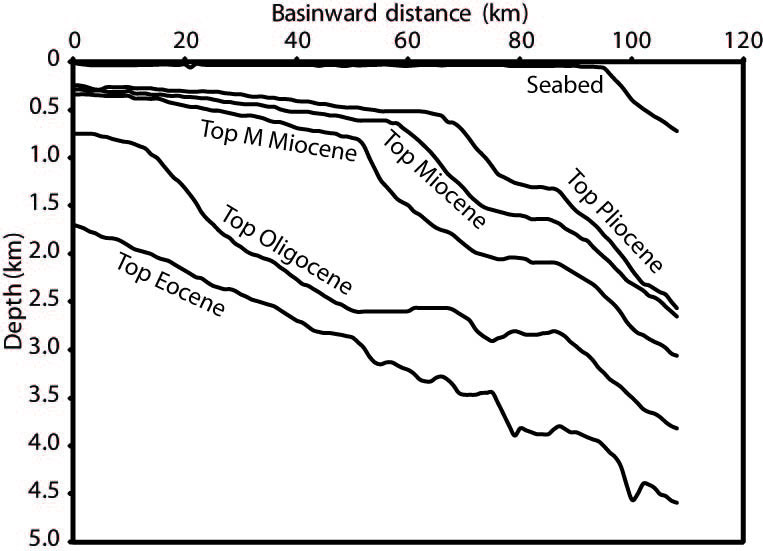|
DYNAMIC STRATIGRAPHY WORKGROUP |
|
Publications and presentations: Publications:
Conference/meeting presentations: Petter, A.L., Mohrig, D., Carvajal, C., Steel, R.J., and Kim, W., 2009, A simple method for estimating the sediment-flux histories of ancient shelf-margin successions: AGU Fall Meeting, San Francisco, California. Petter, A.L., Carvajal, C., Mohrig, D., and Steel, R.J., 2009, Sediment flux and load estimation for ancient shelf-margin successions: AAPG/SEPM Annual Meeting, Denver, Colorado. |
|
People: Andrew Petter, Cristian Carvajal, Ron Steel, David Mohrig, Wonsuck Kim
Research question(s): Estimation of sediment flux for ancient siliciclastic successions has been problematic despite its importance in stratigraphic models, and has most often expressed qualitatively, or with a proxy such as depositional rate. This study develops a simple methodology for estimating sediment flux for ancient shelf-margin successions from sparse datasets. |
|
Shelf-margin clinoforms in the subsurface of the Zambezi Basin, East Africa, reconstructed from seismic cross-section of Walford and others (2005). |
|
Understanding the growth of continents using a simple method for estimating sediment flux from ancient shelf-margin successions |
|
Summary of work: Growth of continents is achieved by accretion of sediment on shelf-margins. The rates and patterns of continental growth are therefore a consequence of the magnitude and distribution of sediment flux across continental margins. Recent work has utilized shelf-margin accretion rates as proxies for sediment flux. Accretion rates are useful for comparing relative sediment flux between different shelf margins but do not give actual values for flux of terrestrial material from continents to the oceans. Quantitative reconstruction of paleo-sediment flux
1) aids understanding of global biogeochemical cycles in the past, 2) allows interpretation of paleoenvironmental conditions in the source area, 3) allows comparison of ancient depositional systems with modern analog systems, and 4) provides input values to constrain boundary conditions for stratigraphic models.
A simple inversion scheme for estimating sediment flux from ancient shelf-margin successions is presented here by treating shelf-margin clinoforms as repetitive similar, stacked forms created by migration at a rate equal to the shelf-margin progradation rate.
Assuming sediment conservation, deposition can be broken into components of 1) response to subsidence and sea-level changes, and 2) basinward migration of the clinoform profile. By combining the wave equation (depositional rate equal to the product of progradation rate and depositional slope) with the Exner equation (depositional rate equal to the spatial change in sediment flux) and a source/sink term (accounting for subsidence and sea-level changes), we integrate for sediment flux and find that at any point along the clinoform profile, the sediment flux is a function of progradation rate, subsidence/sea-level change rate, and elevation of the clinoform profile at that point.
An advantage of this methodology is that it requires only two-dimensional data (i.e. dip-oriented cross-sections) rather than three-dimensional volumes, making it ideal for use with sparse datasets as well as with outcrops. This methodology is also useful for analyzing aerially limited datasets because it can predict the flux of sediment transported beyond the area of data coverage. This approach is able to accurately reproduce the sediment-flux estimates of previous workers from several margins (the Fox Hills-Lewis, Zambezi, New Jersey, and North Slope margins) using both volumetric and forward-modeling methods. Furthermore, the distribution of sediment flux across ancient shelf-margin deposits is shown to be analogous to the distribution predicted by theoretical models while the magnitude of flux is comparable to modern river loads. Transformation of flux estimates into a mass-balance framework indicates that approximately two-thirds of continental sediment is exported off of the shelf into deeper water at long-term geologic timescales. These observations suggest that repetitive delivery of sediment to margins by shelf-edge deltas is fundamental to the long-term process of continental accretion. This finding implies that two-thirds of the terrestrial-derived particulate organic carbon (POC) flux delivered from rivers to the ocean can be stored in deepwater over geologic timescales. The flux of POC from rivers to the oceans is a necessary component for reconstructing the global carbon cycle for the past. |
